North Jersey Roofing vs. Virginia Roofing: Different Weather, Different Solutions
North Jersey roofing and Virginia roofing face dramatically different climate challenges requiring distinct approaches, materials, and maintenance strategies. While both regions experience four seasons, the intensity and duration of winter weather, humidity patterns, and storm exposure create unique roofing demands that contractors in each area must address. Understanding these regional differences helps Northern Virginia homeowners appreciate why roofing practices that work excellently in Bergen County or Essex County might need adaptation for Fairfax or Loudoun Counties, and what valuable lessons North Jersey's harsh climate expertise offers Virginia homeowners seeking maximum roof longevity and performance.
Climate Differences: Snow, Ice, and Temperature Extremes
North Jersey roofing contractors battle significantly harsher winter conditions than their Virginia counterparts. Northern New Jersey receives 25-35 inches of annual snowfall compared to Northern Virginia's 15-22 inches. More importantly, North Jersey experiences longer periods of sustained freezing temperatures, creating ice dam conditions that plague roofs for weeks or months each winter. These conditions demand robust ice and water shield installations, enhanced attic insulation, and ventilation systems preventing heat loss that melts snow and creates destructive ice accumulations.
Virginia's milder winters feature more freeze-thaw cycles rather than sustained freezing. This cycling creates different stress patterns on roofing materials—constant expansion and contraction that accelerates sealant degradation and shingle aging. Virginia roofs also endure higher summer temperatures and humidity levels than North Jersey, promoting algae growth and accelerating organic material decomposition. These climate distinctions require tailored approaches to roof replacement strategies and material selection in each region.
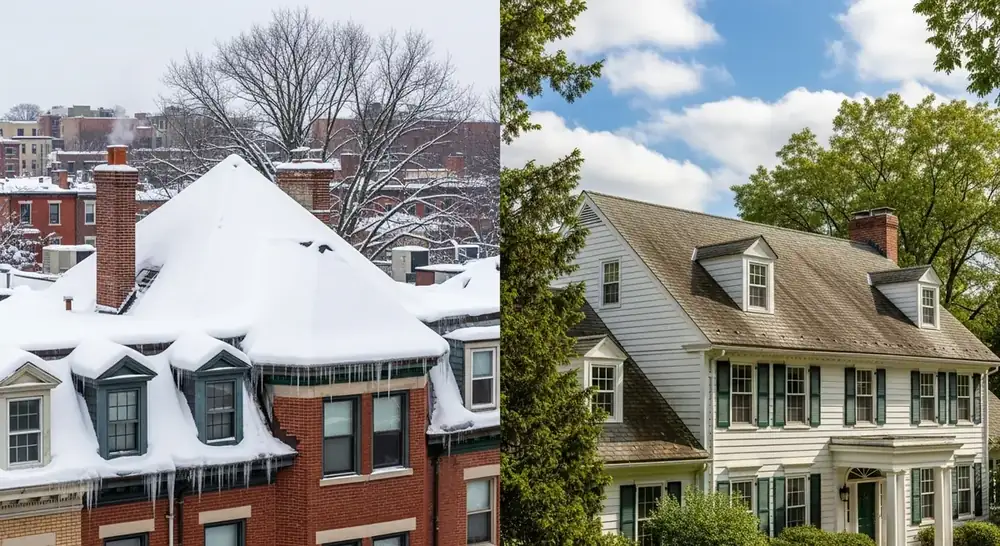
Material Selection: Regional Priorities
North Jersey roofing contractors prioritize materials engineered for extreme cold, heavy snow loads, and ice dam resistance. They frequently specify premium architectural shingles rated for severe weather exposure and impact resistance from ice chunks. Modified bitumen and synthetic underlayments with superior cold-weather flexibility prevent cracking during temperature extremes. Ice and water shield coverage extends beyond Virginia code minimums, often covering entire roof planes rather than just eaves and valleys.
Virginia roofing emphasizes different material properties—algae resistance for humid summers, thermal cycling durability for frequent freeze-thaw patterns, and wind resistance for severe thunderstorms and occasional hurricanes. Virginia contractors increasingly specify cool roof materials reflecting solar radiation to reduce cooling costs during hot, humid summers. While both regions use similar base products, the specific formulations, ratings, and installation practices differ significantly based on predominant climate stresses. Understanding these regional material considerations helps when planning metal roofing installations or premium shingle upgrades.
Ice Dam Prevention: North Jersey Expertise
North Jersey roofing contractors developed ice dam prevention expertise through necessity—their harsh winters make ice dams annual threats rather than occasional problems. Their comprehensive approach combines proper attic insulation maintaining consistent temperatures, adequate ventilation preventing heat accumulation, and strategic ice and water shield placement protecting vulnerable areas. Many North Jersey installations include heated cable systems along eaves and valleys providing active ice prevention during severe weather.
Virginia homeowners benefit from adopting these North Jersey ice dam prevention practices even though our milder winters make ice dams less frequent. The occasional severe winter that brings extended freezing can catch Virginia roofs unprepared, causing thousands in water damage. Implementing North Jersey-style ice and water shield coverage and ensuring proper attic insulation provides insurance against these periodic severe conditions. The modest investment in enhanced ice protection pays dividends during the inevitable harsh winter that tests Virginia roofs beyond normal expectations. These preventive measures complement proper roof repair practices when problems develop.
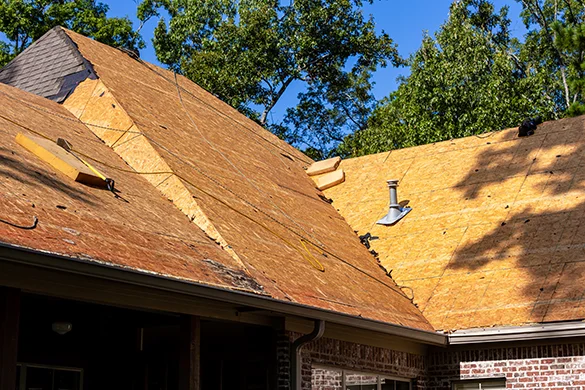
Ventilation Strategies: Regional Approaches
North Jersey roofing emphasizes ventilation preventing ice dams and controlling attic moisture during long heating seasons. Ridge vents combined with soffit vents create continuous airflow maintaining uniform roof deck temperatures. Powered attic fans supplement passive ventilation in complex roof geometries where natural airflow proves insufficient. The goal focuses primarily on winter performance—preventing heat loss that creates ice dams while managing condensation from temperature differentials.
Virginia roofing ventilation addresses different priorities. While preventing ice dams matters, managing summer heat buildup and controlling humidity-driven moisture prove equally important. Virginia attics can reach 150°F during summer, cooking shingles from below and drastically reducing lifespan. Effective ventilation systems remove this heat, extend shingle life, and reduce cooling costs. Virginia contractors balance year-round performance rather than optimizing primarily for winter conditions. Both approaches offer valuable insights—Virginia homeowners benefit from North Jersey's ice dam expertise while maintaining focus on heat management critical for Mid-Atlantic summers.
Storm Resistance: Different Threats
North Jersey roofing weathers nor'easters delivering sustained high winds and heavy precipitation over days. These prolonged events test roof integrity differently than Virginia's severe thunderstorms featuring intense winds and rainfall over hours. North Jersey installations emphasize wind resistance through proper fastener patterns, edge metal securing loose corners, and impact-resistant materials handling wind-blown debris. Coastal North Jersey areas also address salt air corrosion requiring corrosion-resistant fasteners and flashings.
Virginia roofs face severe thunderstorm winds reaching 70-90 mph, occasional tornadoes, and periodic hurricane impacts bringing sustained winds and flooding rains. Virginia contractors specify materials rated for high wind zones, ensure proper deck attachment, and design drainage systems handling extreme rainfall rates. While both regions demand wind resistance, the storm patterns differ enough that installation practices vary. Learning from both regional approaches creates roofing systems handling the full spectrum of severe weather threats affecting the Mid-Atlantic region. These considerations apply whether installing commercial flat roofing or residential systems.
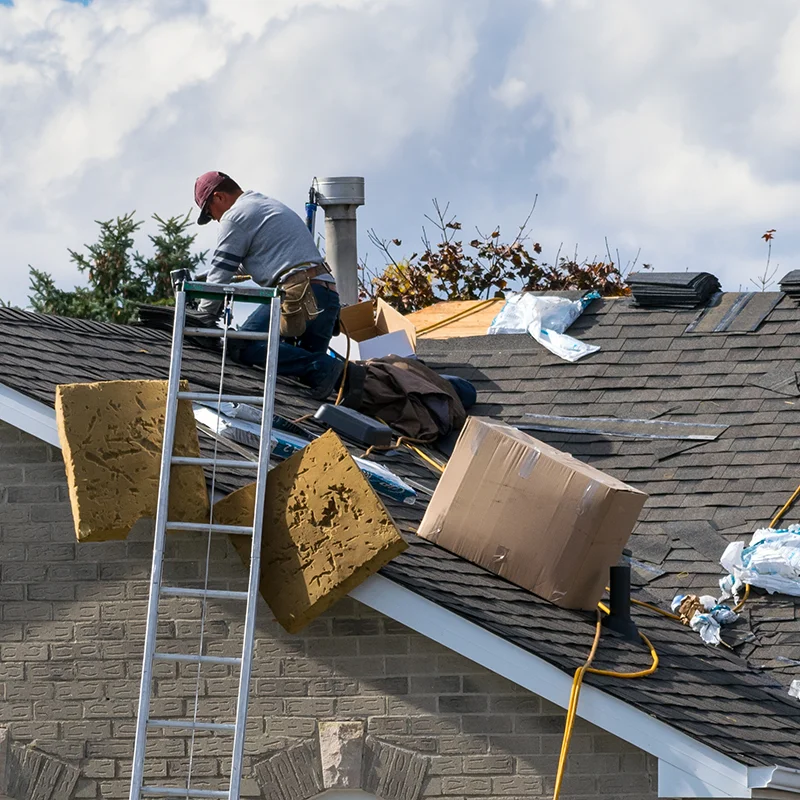
Building Code Differences
North Jersey operates under stringent building codes addressing harsh climate realities. Snow load requirements exceed Virginia standards, demanding stronger roof framing and pitch considerations. Ice dam prevention measures often exceed code minimums as standard practice. Energy code requirements emphasize heating efficiency and moisture control critical for cold climates. These stricter standards drive higher installation costs but deliver roofs engineered for worst-case conditions.
Virginia building codes balance broader climate considerations. While snow load requirements exist, they're less stringent than North Jersey's. Virginia codes increasingly emphasize energy efficiency addressing both heating and cooling needs. Wind resistance requirements account for hurricane exposure in coastal areas while recognizing lower wind threats inland. Understanding these code differences explains why identical roofing products might be installed differently in each region—practices meeting North Jersey codes exceed Virginia minimums but provide enhanced protection Virginia homeowners appreciate during severe weather.
Maintenance Practices: Seasonal Focus
North Jersey roofing maintenance centers on pre-winter preparation and post-winter damage assessment. Fall inspections address sealant integrity, flashing condition, and gutter functionality before snow and ice arrive. Spring evaluations identify ice dam damage, check for water infiltration, and address winter stress impacts. Summer maintenance proves less critical in North Jersey's moderate summers, though contractors recommend biannual comprehensive inspections as best practice.
Virginia roof maintenance requires year-round attention addressing seasonal threats differently. Spring inspections follow winter freeze-thaw cycles and severe weather season. Summer checks identify storm damage and address algae growth thriving in humid conditions. Fall maintenance prepares for winter while managing leaf accumulation from our extensive tree coverage. Winter inspections after major storms ensure ice events haven't compromised roof integrity. This continuous maintenance cycle reflects Virginia's variable weather patterns affecting roofs throughout the year rather than concentrating stress in one season. Regular maintenance practices help avoid costly leak repair situations requiring emergency service.

Cost Considerations: Regional Pricing
North Jersey roofing typically costs 15-25% more than comparable Virginia installations reflecting higher labor costs, stricter code requirements, and enhanced material specifications addressing harsh climate. New Jersey's higher cost of living drives contractor rates up while material costs remain similar. The enhanced installations North Jersey's climate demands—extensive ice and water shield coverage, superior ventilation systems, and premium materials—add costs justified by climate necessity.
Virginia's moderate climate allows more flexibility in material selection and installation practices without sacrificing performance. Homeowners can choose between builder-grade solutions adequate for our climate and premium installations offering North Jersey-level protection at higher cost. Understanding these cost-performance tradeoffs helps Virginia homeowners make informed decisions about appropriate protection levels for their specific situations, neighborhoods, and budget parameters. While Virginia doesn't require North Jersey's stringent approaches, adopting some practices provides enhanced protection worth considering.
Architectural Styles and Roofing Implications
North Jersey's architectural heritage features steep-pitched roofs, complex geometries, and premium materials reflecting the region's affluence and harsh climate requirements. Steep pitches shed snow effectively while creating challenging installation conditions. North Jersey contractors develop expertise with slate, tile, and architectural shingles on complex roof planes featuring multiple valleys, dormers, and transitions requiring advanced flashing skills.
Virginia architecture spans colonial styles with moderate pitches to contemporary designs with various roof configurations. Our generally milder climate historically allowed lower-pitch roofs, though modern construction increasingly adopts steeper pitches for aesthetic and performance reasons. Virginia contractors work with diverse architectural styles requiring adaptability across material types and installation approaches. Both regions demand skilled craftsmanship, though the specific challenges differ based on predominant architectural styles and climate-driven design requirements. These regional architectural differences influence decisions when planning exterior upgrades and comprehensive home improvements.
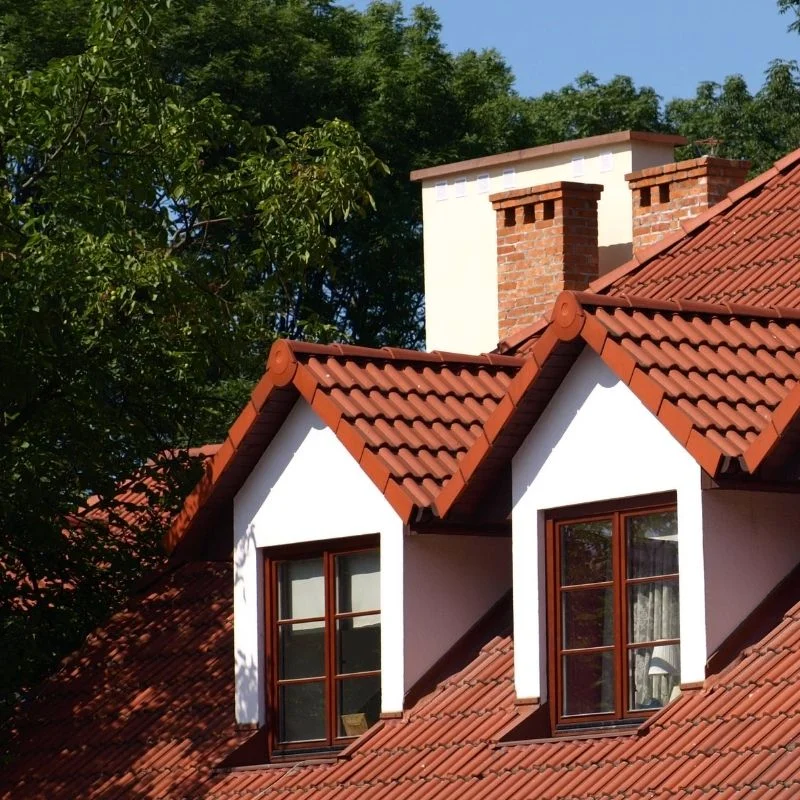
Lessons Virginia Homeowners Can Apply
Virginia homeowners benefit from adopting several North Jersey roofing practices even though our climate doesn't strictly require them. Enhanced ice and water shield coverage beyond code minimums provides protection during occasional severe winters. Superior attic insulation and ventilation systems designed for harsher climates deliver year-round benefits through better temperature control and moisture management. Premium material selections engineered for North Jersey's extremes typically exceed Virginia's demands, providing performance margins that extend roof life.
North Jersey's emphasis on thorough inspections and preventive maintenance translates well to Virginia conditions. While our climate stresses roofs differently, the principle of proactive care preventing expensive problems applies universally. Quality installation practices North Jersey contractors employ—meticulous flashing details, proper fastener patterns, and comprehensive underlayment coverage—deliver enhanced performance in any climate. Adapting these practices to Virginia conditions creates roofing systems exceeding local standards while remaining cost-effective.
What North Jersey Contractors Can Learn From Virginia
The knowledge exchange works both directions. Virginia's extensive experience with algae-resistant shingles, heat-reflective roofing materials, and ventilation systems optimized for hot, humid summers offers insights valuable for North Jersey's warming climate. As climate patterns shift, North Jersey increasingly faces summer heat and humidity challenges Virginia contractors have addressed for decades. Cool roof technologies, moisture management in humid conditions, and material selections balancing year-round performance represent areas where Virginia expertise benefits northern contractors.
Virginia's cost-effective approaches to roof protection without over-engineering for rare events provide lessons in value optimization. North Jersey contractors sometimes over-specify solutions for worst-case scenarios, creating costs exceeding benefit for average conditions. Virginia's climate-appropriate rather than maximum-protection approach demonstrates how thoughtful material selection and installation practices deliver excellent performance at reasonable cost. Both regional approaches offer valuable perspectives contractors and homeowners benefit from understanding.
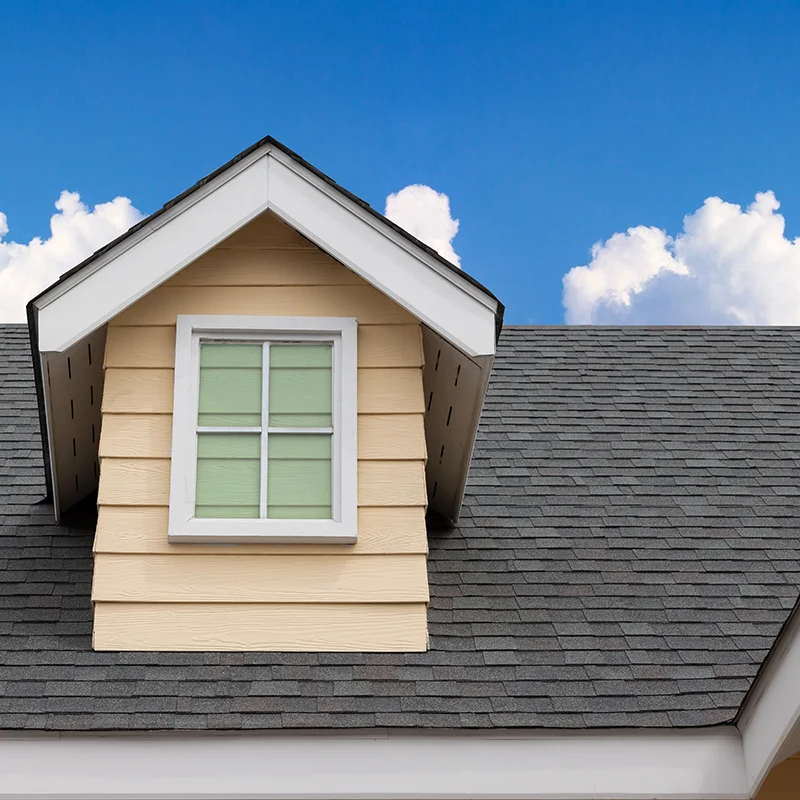
The Value of Regional Expertise
Both North Jersey roofing and Virginia roofing demonstrate the importance of regional expertise addressing specific climate challenges, building practices, and architectural styles. National roofing companies applying generic solutions regardless of location miss critical regional nuances that affect long-term performance. Local contractors understanding specific weather patterns, code requirements, and material performance in regional conditions deliver superior results through climate-appropriate rather than one-size-fits-all approaches.
When selecting roofing contractors for Reston, McLean, Vienna, or other Northern Virginia locations, prioritize those with extensive local experience understanding our specific climate challenges. While learning from North Jersey's harsh-climate expertise proves valuable, contractors must adapt those lessons to Virginia conditions rather than simply replicating northern practices. The best Virginia contractors study successful approaches from challenging climates while optimizing specifically for Mid-Atlantic weather patterns, creating balanced solutions delivering excellent performance and value.
Climate Change Implications for Both Regions
Climate change affects both North Jersey and Virginia roofing, though impacts differ by region. North Jersey experiences warmer winters with more rain and less snow, creating different moisture management challenges than historical patterns. More frequent freeze-thaw cycles stress materials in new ways. Virginia sees increased severe weather frequency, higher summer temperatures, and more intense precipitation events. Both regions face evolving conditions requiring adaptive strategies rather than relying on historical climate patterns.
Forward-thinking roofing contractors in both regions increasingly specify materials and systems handling broader performance ranges. Premium impact-resistant shingles, enhanced drainage capacity, and superior ventilation systems address intensifying weather extremes. Virginia contractors adopt some North Jersey ice protection practices as occasional severe winters become more common. This climate-adaptive approach protects homeowners' investments against uncertain future conditions while maintaining appropriate cost-effectiveness for current realities.
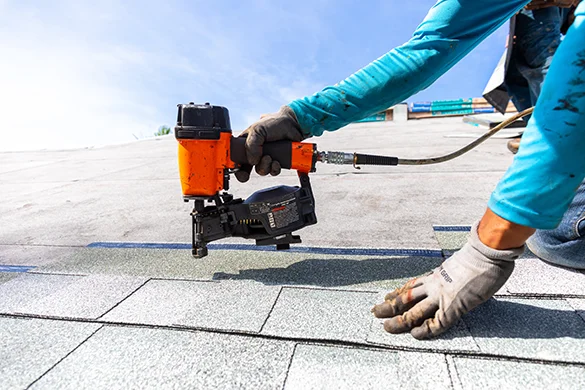
Making Informed Decisions for Your Virginia Roof
Understanding how North Jersey roofing differs from Virginia roofing helps homeowners make informed decisions about appropriate protection levels for their specific situations. While Virginia's moderate climate doesn't demand North Jersey's stringent approaches, adopting selected practices provides enhanced protection worth considering. Balance climate-appropriate specifications with value optimization—over-engineering for conditions unlikely in Virginia wastes money while under-protecting risks expensive damage during severe weather.
Work with experienced Virginia contractors who understand both regional best practices and valuable lessons from harsher climates. Ask about their approach to ice dam prevention, ventilation design, and material selection. Contractors demonstrating knowledge of different regional practices while maintaining focus on Virginia-specific needs provide the expertise homeowners should seek. The best solutions adapt proven practices from challenging climates to Virginia conditions, creating roofing systems exceeding local standards without unnecessary costs.
Contact Reston Roof for Virginia-Optimized Roofing Solutions
At Reston Roof, we combine extensive Northern Virginia experience with knowledge of roofing best practices from challenging climates including North Jersey. Our approach adapts proven cold-climate techniques to Virginia conditions, providing enhanced protection appropriate for our specific weather patterns. We understand what Virginia roofs need to perform excellently through our variable seasons while incorporating lessons from regions facing harsher conditions.
Whether you need complete roof replacement, expert repairs, or guidance on upgrading to premium materials, our team delivers solutions optimized for Northern Virginia's climate, architecture, and homeowner expectations. We serve Reston, Oakton, Herndon, Sterling, and throughout Fairfax and Loudoun Counties with local expertise backed by industry-leading practices. Contact us at (571) 453-6515 to discuss your roofing project and discover how regional expertise combined with climate-adaptive approaches protects your home for decades.
